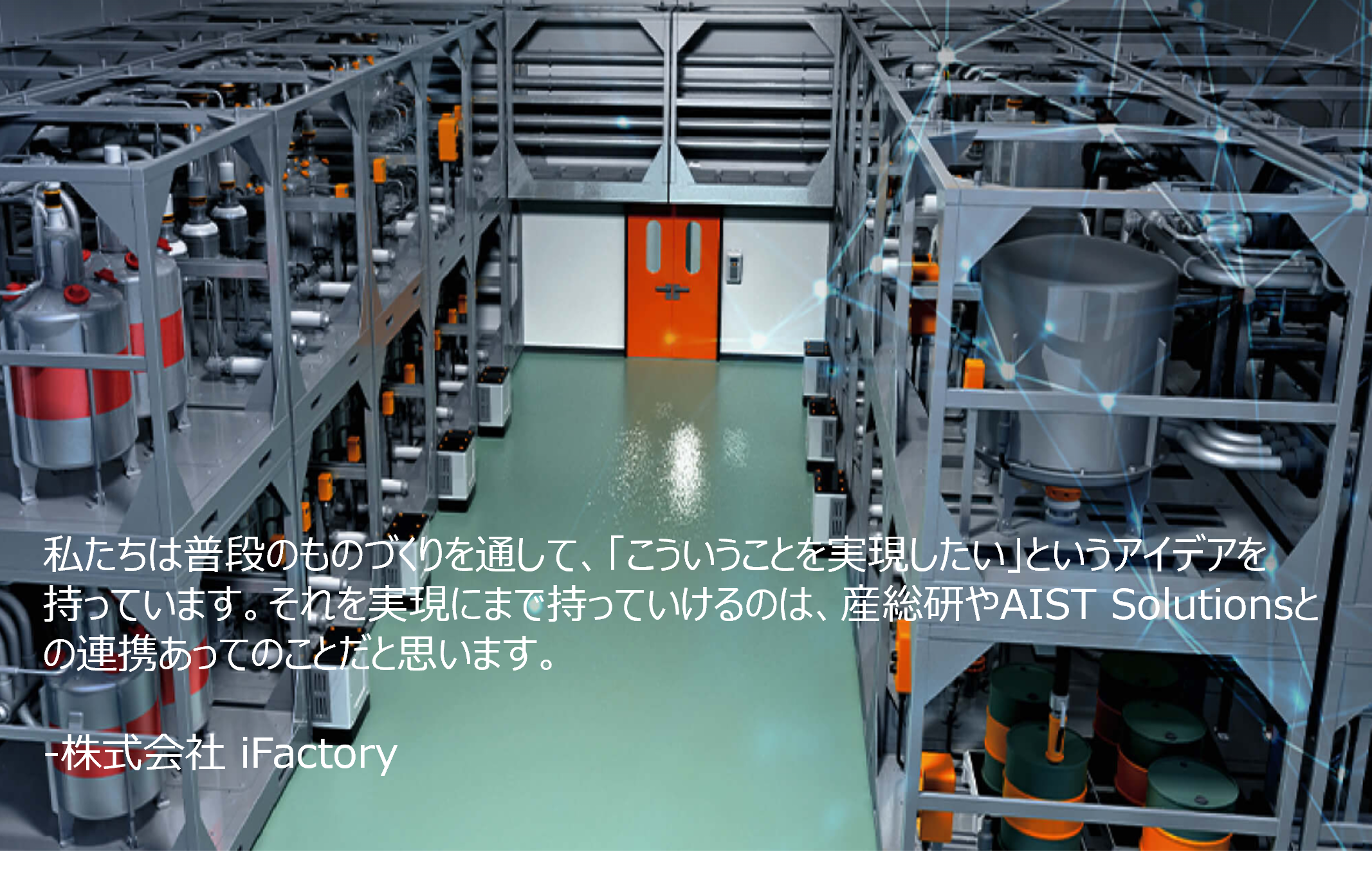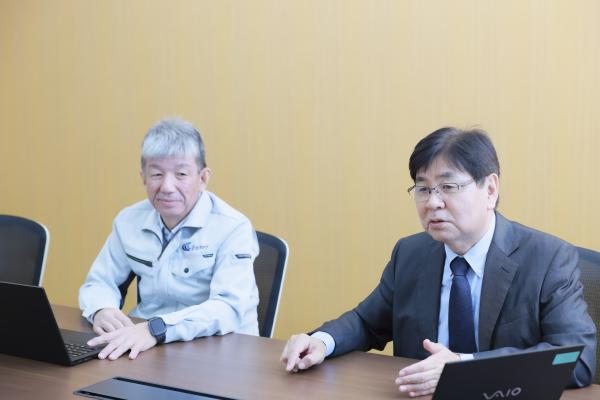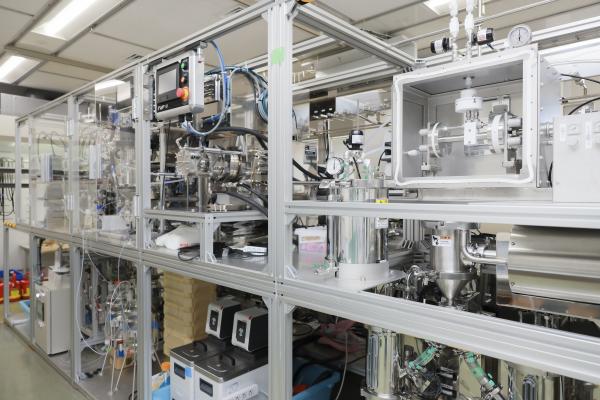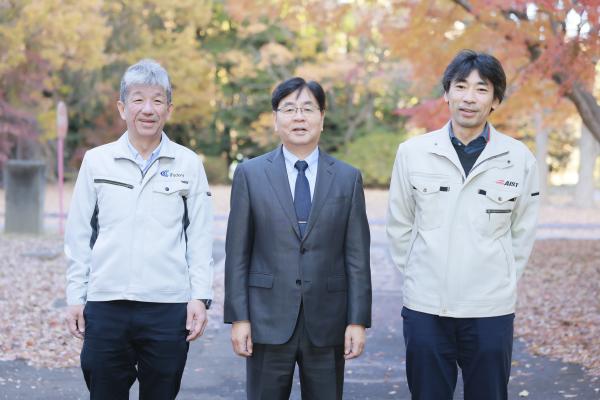We believe that we can make ideas into reality through our usual approach to manufacturing. That we can hold onto this belief all the way through is thanks to our partnerships with AIST and AIST Solutions.
iFactory Inc.

【Persons interviewed】
Takao Saito, Representative Director & President
Tatsuro Uno, Director & Executive Field Engineer
Saving manpower and energy through the practical application of iFactory, a continuous production system that will eventually constitute infrastructure for pharmaceutical manufacturing
iFactory Inc. (hereinafter referred to as “iFactory”) was certified as an AISol startup(*) in October 2023. iFactory is the name given to modular, fully automated continuous production installations provided by the company. These installations enable continuous production by modularizing and interconnecting unit operations (such as reaction, extraction, crystallization, filtration, and drying) needed to manufacture pharmaceuticals and fine chemicals, thereby leading to labor savings, a more compact arrangement, and energy savings in production.
The National Institute of Advanced Industrial Science and Technology (hereinafter referred to as “AIST”; currently includes AIST Solutions Co.) has been involved in the development of the foregoing and contributing to the commercialization of iFactory since 2018. AIST Solutions will continue to collaborate with iFactory to engage in work to further promote the development of technologies, business operations, and dissemination. In this connection, we sat down with Takao Saito, Representative Director & President of iFactory, and Tatsuro Uno, Director & Executive Field Engineer of the company, to talk about the advantages of collaborating with AIST (AIST Solutions) and what they believe their partnership with AIST Solutions will look like in the years to come.
*AIST Solutions promotes the co-creation of businesses by certifying startup companies that are expected to contribute to the attainment of the AIST Group’s mission statement from the perspective of helping solve societal issues, maintaining a technological competitive edge, promoting marketability, and harnessing synergy with AIST as AISol startups.
We wish to engage in the large-scale development of technology for continuous production, which will surely become a global trend.
Saito: We were established in April 2019 in order to commercialize iFactory, which is the name given to modular, fully automated continuous production installations that the New Energy and Industrial Technology Development Organization (NEDO) had been working to develop since fiscal year 2018 as a thematic pillar of its strategic energy conservation technology innovation program. Participating in the development of iFactory were the following eight companies: Takasago International Corporation, for which I serve as chairman, as well as Mitsubishi Tanabe Pharma Corporation, Konica Minolta Chemical Co., Ltd., Yokogawa Solution Service Corporation, TEC Project Services Corporation, Taisei Corporation, Shimadzu Corporation, and Mitsubishi Kakoki Kaisha, Ltd. (hereinafter each company shall be referred to without referencing their nominal corporate status). AIST joined this group, worked on practical matters related to development together with researchers dispatched from each company, secured government funds, provided research facilities, and spearheaded development work.
The idea for iFactory was first conceived around 2012. The company to which I belong, Takasago International Corporation, is often commissioned by major pharmaceutical companies to manufacture pharmaceutical intermediates. However, we were told that the conventional method of producing such products on a batch basis would no longer be entrusted to Japanese companies since Japanese companies were no longer competitive in cost terms with the Chinese. We were struck by a sense of crisis that made us believe that we had to evolve in some way in order to survive.
Our focus turned to the notion of continuous production. Chemical products are produced through a multi-step process whereby thousands or tens of thousands of liters of a given product are produced in batches where each step of the process is independently performed. For continuous production, in contrast, every step of the process – from beginning to end – is connected. The targeted production volume can be achieved for a small order of, say, 100 liters by engaging in continuous production for an extended period of time.
The huge advantage of the continuous production method is that you can adjust the volume of production by changing the operating hours or engage in small-lot multi-product production runs by reconfiguring unit operations to meet a wide range of needs. In addition, labor savings can be attained since there is little work that needs to be performed by actual humans. Since equipment is also made smaller, space savings can be had. If the equipment is made smaller, you need less cleaning agents to wash equipment, which in turn lessens the environmental impact. In the event that an explosive accident was to occur, you can also minimize the amount of damage you sustain compared to the batch method of production. The continuous production method mitigates the risk that problems will arise. Problems are prone to occur when equipment is turned on or shut down. Since equipment is turned on and shut down every time there is a transition from one process to another with the batch method of production, you run the risk each time that something unexpected happens. With the continuous production method, however, the production process will proceed uninterrupted to the end once production is commenced, which means that such a risk can be minimized, and quality will be stabilized.
In the pharmaceutical sector in recent years, the trend has been to require the production of a large number of different products in small lots in order to accommodate a wide variety of diseases and conditions. The U.S. Food and Drug Administration (FDA) has also issued guidelines recommending the continuous production method, lending credence to the belief that we see a shift from the batch method to the continuous production method taking place in the industry. Since substantial costs and time are incurred for the development of equipment capable of carrying out continuous production, however, it is a task that was considered to be impossible for any single company to undertake on its own.

(Left; Uno; right: Saito)
It began as a national project spurred on by encouragement expressed by AIST
Saito: Amid these circumstances, AIST and the University of Tokyo launched a consortium on continuous production, and I came to join this consortium as an executive secretary in around 2015. Since consortiums are essentially just vessels for the exchanging of information, however, I set up a committee within the consortium to explore the implementation of continuous production in society as I really wanted to somehow discuss the feasibility of continuous production.
With many companies being interested in the notion of continuous production, this committee has thirty-seven corporate participants. Despite strong enthusiasm for the idea, the fact is that infrastructure is expensive to build. It was in this space that AIST emerged to play a role. AIST is always consulting with such parties as the Ministry of Economy, Trade and Industry in trying to determine what kinds of projects for the development of technology should be undertaken for the sake of Japan’s future. Continuous development came to constitute a pillar of the government’s technology development focus as a result of the efforts made by AIST. The promotion of projects was taken up by NEDO and two-thirds of the necessary funds were to be constituted by government subsidies. The remaining third is to be assumed by each company that has committed itself to bringing about results within the five-year period to the end of the project with which it is associated. In this way, companies demonstrate how serious they are in these ventures.
Uno: At the end of the day, the companies who chose to join us were the eight listed earlier in this interview. Three research-oriented companies—Takasago International, Mitsubishi Tanabe Pharma, and Konica Minolta Chemical—conducted joint demonstration testing with AIST. On the other hand, five companies, including Yokogawa Solution Service, worked on development equipment and facilities. In addition to providing research locations, AIST served as the focal point for connecting all of the companies in this project, addressed procedures necessary for development, and led the way for the consolidation of ideas and the changing of plans. Where time might be wasted as a result of companies experiencing difficulties reconciling each other’s needs even when it came to confidentiality agreements, we were grateful that AIST managed to step in to take control and chart a course towards a resolution that worked for everyone’s benefit.
Saito: Since we had to produce results through this project within five years, we wondered how we could combine equipment and facilities that already existed in such a way that continuous production could be rendered possible. What we struggled with was figuring out how we could get heterogenous equipment and systems to connect with one another. When it came to systems in particular, there was concern as to our ability to ensure compatibility among different systems as they came to be connected together.
We carried out a series of trial-and-error actions and revised plans countless times as we plugged away. In the last three months prior to the end of the project, we kept on working out the details while making changes to the plan a total of sixty-eight different times. Our goal was to produce three compounds using the equipment that we developed for this project. This goal was ultimately met and our program at NEDO came to an end in July 2023.
What I came to realize through this project was that the setting can have a huge impact on research. When you leave your own company or lab to come to AIST, you can be freed from your day-to-day constraints and immerse yourself fully in research and development, such that you can rediscover the passion you have for what you do. I believe that it was very important that AIST was able to serve as a setting in which we were given the chance to fulfill our dreams outside of the constraints placed upon us by our own companies. If we had each sought to do what we did back at our respective companies, the results we actually achieved would probably have been beyond our reach.
Commercial viability has been achieved after five years of development and orders have already been placed by a number of companies
Uno: The iFactory system we developed packages a unit operation for production in each 2.32 cubic meter cube. Rearranging cubes enables the production of different items. We worked on developing this system by striving to place every conceivable unit operation into its own cube. Achieving this objective meant that installations could fit into one-third of the floor space needed for the batch method of production. These cubes can also be easily rearranged with a forklift.
Saito: Our cubes are of a height that does not subject them to restrictions under the Road Traffic Act. Three cubes together are the same size as a typical container, which means that they can be loaded onto a truck, train, or ship and transported anywhere. For this reason, assuming that nothing in the law blocks us from taking such actions, we can even transport cubes to a disaster-stricken area on an emergency basis and produce drugs on-the-spot.
Uno: Using iFactory allows unit operations that used to require a dozen or so persons to complete to be done with just one or two persons. In the future, we would like to enable fully remote operations for everything from the issuance of production instructions to actual production and an entire plant to be managed by just two persons.
In addition, a considerable amount of energy is consumed when starting up equipment. By being kept in an idling state at all times, the iFactory system can eliminate the need for energy to start up equipment. We changed the mechanism for centrifuges, conventional versions of which consume large amounts of energy, to one that does not require much energy to run. Typically, a centrifuge works by spinning several thousand times a minute at very high speeds to create enough centrifugal force to separate and dry compounds. By replacing such centrifuges with equipment featuring a mechanism that can separate and dry with just a few revolutions allowed energy consumption to be cut by 80 percent compared to conventional options.
Saito: We’ve already fielded orders from some companies and are working on shipping equipment in fulfillment of some of these orders. We have also concluded consulting agreements through which we use cubes to try to figure out with clients what sorts of items they should produce. We’ve managed to establish a nice base for ourselves through this five-year project and will now team up with clients to which deliveries are made to determine how we can customize setups for their benefit. We estimate that the process from design to implementation will take two to three years and would like to proceed with this endeavor by collaborating with AIST Solutions. We are also in talks with AIST Solutions on joint research to resolve issues that have come up to date. We hope to receive support in various ways on matters having to do with the promotion of business that cannot be properly addressed by a small startup.

(Fully automated continuous production installations set up inside AIST’s Tsukuba Center)
If you come to us with an idea, we can create a new business for you with AIST’s technological prowess
Saito: Our goal for the future is to make it possible to replace manufacturing equipment in plants across Japan with iFactory cubes. iFactory’s biggest advantages are labor and energy savings. Japan’s population is expected to shrink by 30 to 40 percent in the next three decades. If this comes to pass, it will be impossible to maintain the current systems of production in place. We would like to disseminate iFactory as an element of the production infrastructure and achieve labor savings in advance of what is going to happen demographically. At the same time, we should also promote progress on the question of carbon neutrality through energy-saving initiatives. We also aim to achieve 100% domestic production of pharmaceuticals with the dissemination of the iFactory system. Japan now relies on imports for 65 percent of our pharmaceutical drugs. An inability to import such drugs will cause such commercially available drugs as medicine to bring down a fever and cough suppressants to become unavailable and the lifestyles to which we have become accustomed to becoming disrupted. Since such drugs generate low profit margins for pharmaceutical companies, the domestic production of such drugs is largely unfeasible at the moment. We hope to resolve this issue with the iFactory system.
Uno: Highly skilled Ultraman-like human resources would be needed if we are to attain this goal. As we are significantly short on manpower these days, we are naturally recruiting potential employees as well as casting our net widely in hopes of convincing companies who would be eager to participate in this sort of project to loan us people who could be of use. We would definitely hope that such loaned workers would eventually bring back technical expertise learned from their time with us to their own companies to promote the notion of continuous production.
Saito: We will continue to collaborate with AIST and AIST Solutions. As everyone at AIST possesses a solid level of skills and creativity, we hope to continue to rely on their advanced technical capabilities. We entertain ideas of what we would like to achieve through routine manufacturing. It is through our partnerships with AIST and AIST Solutions that we are able to see these ideas ultimately realized.
Uno: When AIST Solutions became a company operating independently of AIST in April 2023, it became possible to develop technologies with the goal of developing new businesses with AIST as well. If there is a business idea you have in mind, you should definitely reach out to AIST Solutions to see how you can develop it into something real.

(Left: Uno; middle: Saito; right: Komura )